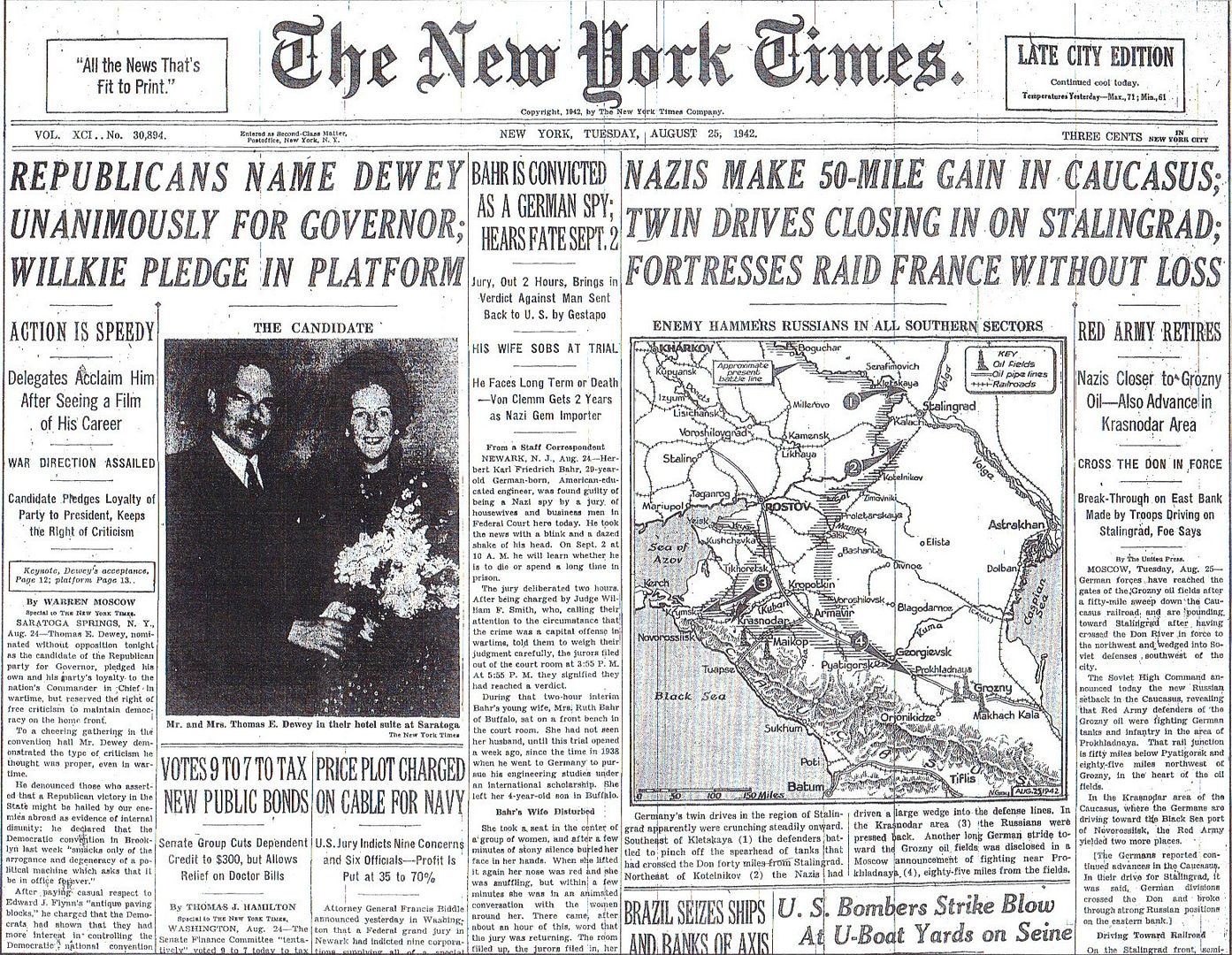
Posted on 08/25/2012 6:03:01 AM PDT by Homer_J_Simpson

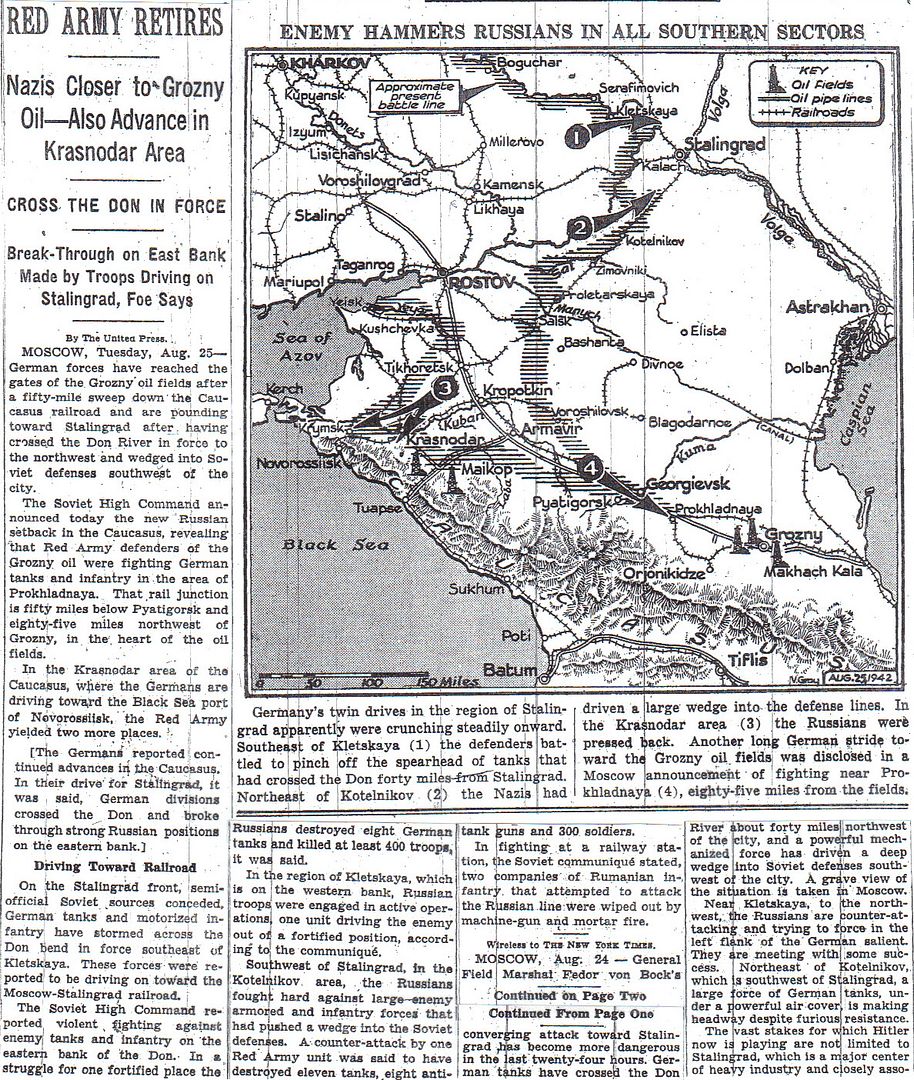


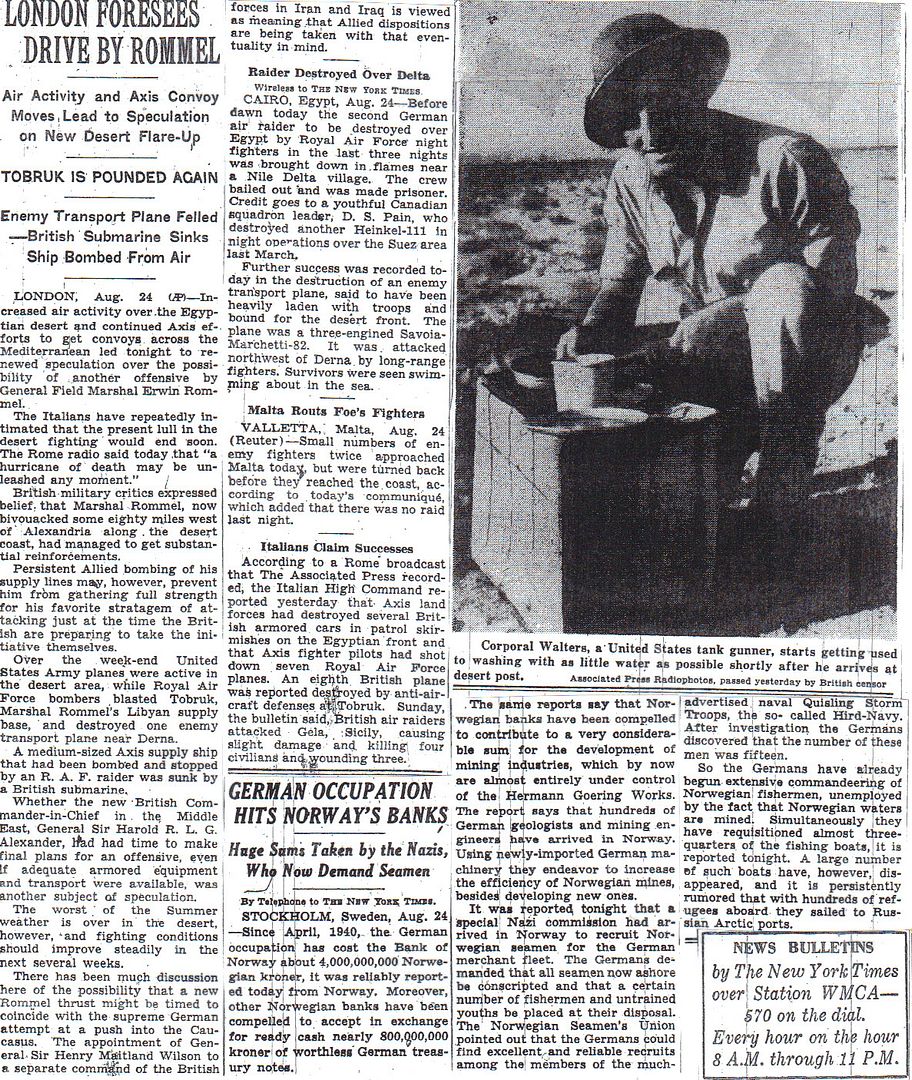
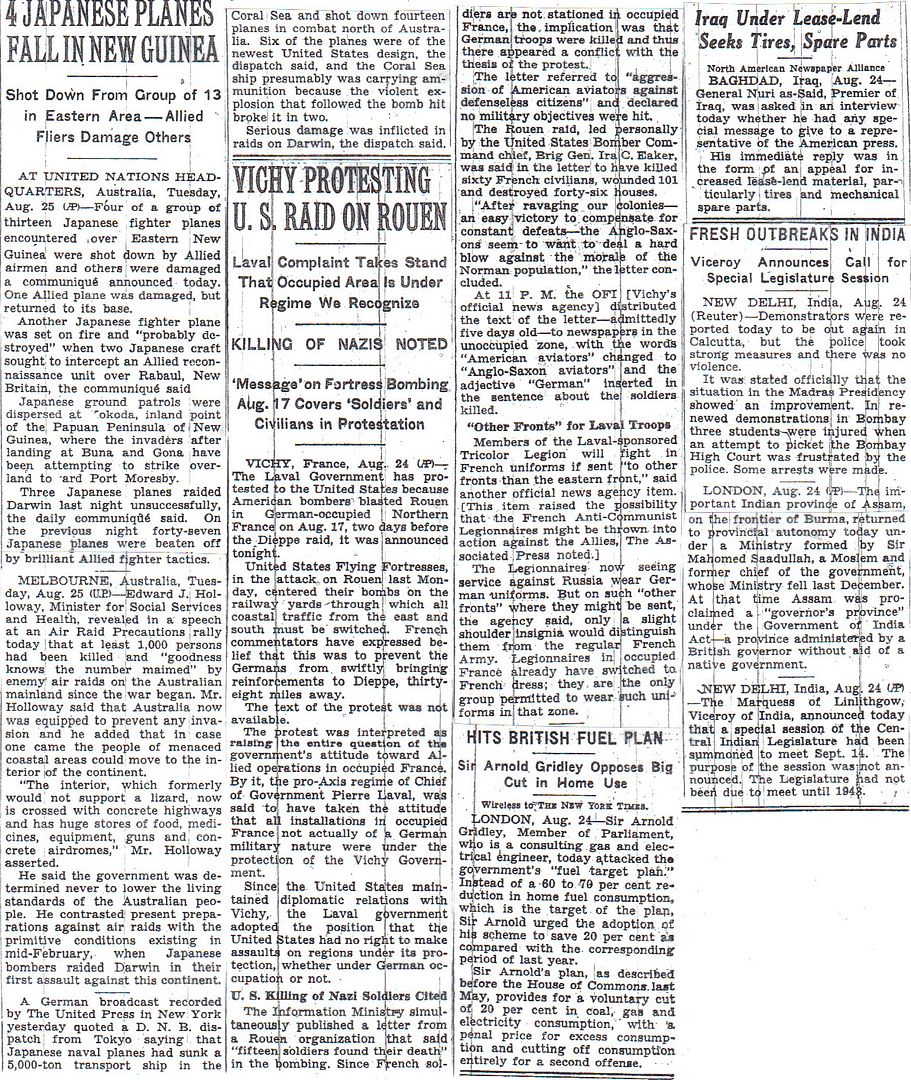
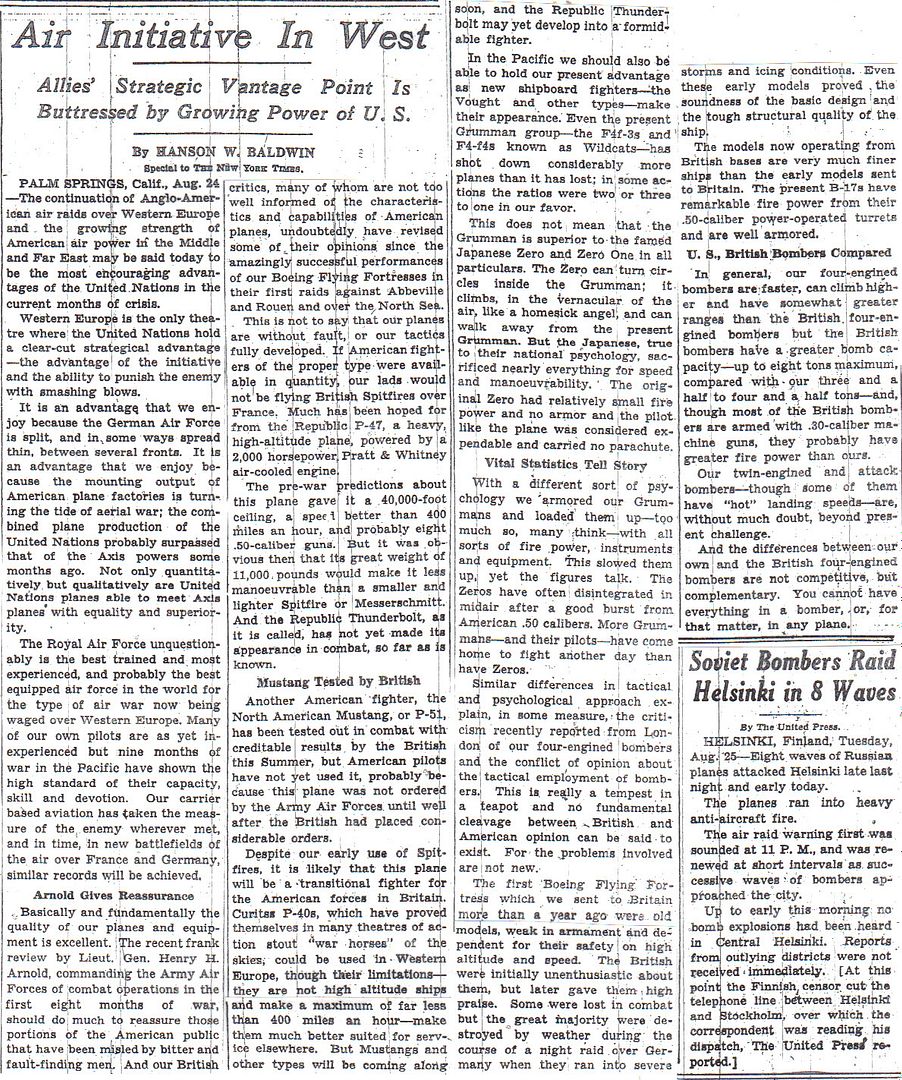
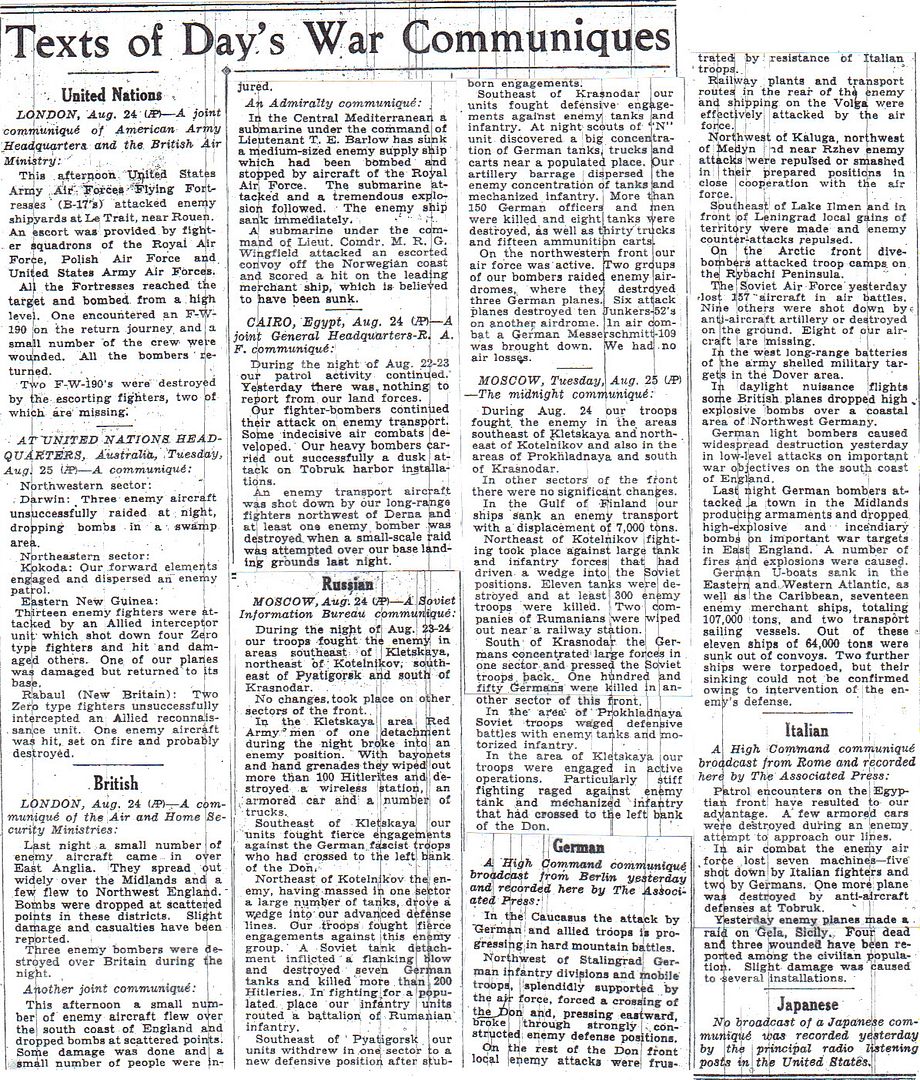

John Toland, The Rising Sun: The Decline and Fall of the Japanese Empire, 1936-1945
Red Army Retires – 2-3
War News Summarized – 3
More Bad News for Rommel: Allied Reinforcements Arrive in Egypt (photos) – 4-5
London Foresees Drive by Rommel – 5
Air Initiative in West (Baldwin) * – 7
Texts of Day’s War Communiques – 8
* Palm Springs?
http://www.onwar.com/chrono/1942/aug42/f25aug42.htm
Red Army resists German advance
Tuesday, August 25, 1942 www.onwar.com
Red Army troops operating lend-lease British tanks in the Caucasus [photo at link]
On the Eastern Front... The is heavy fighting between German and Soviet forces along the Terek River in the Caucasus. Fighting is especially fierce near Mozdok.
From London... An announcement is made that the Duke of Kent, (younger brother to the King) has been killed in a plane crash in the north of Scotland.
In New Guinea... Japanese attack on Milne Bay begins. Their landings are fiercely resisted by the Australian and American garrison. In other fighting near the Kokoda Trail, the Japanese gain some ground near Isurava.
From Moscow... The Soviet government announces that a two week old offensive on the 75 mile long Moscow Front has been successful.
IN the area of First Panzer Army, which formed the eastern part of Army Group A, the 16th Motorized Infantry Division was covering the exposed left flank by means of a chain of strongpoints.
The date was 13th September 1942, and the place was east of Elista in the Kalmyk steppe.
"Hurry up and get ready, George-we're off in an hour!"
"Slushayu, gospodin Oberleutnant-yes, sir," shouted George the Cossack, and raced off.
First Lieutenant Gottlieb was delighted with his eagerness. George came from Krasnodar. He had learnt his German at the Teacher Training College there. In the previous autumn, while acting as a messenger, he had run straight into the arms of the motor-cyclists of 16th Motorized Infantry Division. Since then he had been doing all kinds of services for 2nd Company—first as assistant cook and later, after volunteering for the job, as interpreter. George had numerous good reasons for disliking Stalin's Bolshevism, and there was not a man in the company who did not trust him.
In particularly critical situations George had even helped out as a machine-gunner.
Lieutenant Gottlieb had just returned from a conference with the Commander of Motorcycle Battalion 165—the unit which later became Armored Reconnaissance Battalion 116.
There the last details had been discussed for a reconnaissance operation through the Kalmyk steppe to the Caspian Sea.
Lieutenant-General Henrici, commanding 16th Motorized Infantry Division, who had recently relieved LII Corps at Elista, wanted to know what was going on in the vast wilderness along the flank of the Caucasus front. Between the area south of Stalingrad and the Terek river, which 3rd Panzer Division had reached near Mozdok on 30th August with 394th Panzer Grenadier Regiment under Major Pape, there was a gap nearly 200 miles wide. Like a huge funnel this unknown territory extended between Volga and Terek, the base of the triangle being the coast of the Caspian Sea. Any kind of surprise might come from there. That was why the area needed watching.
The task of guarding this huge no-man's-land had been assigned at the end of August to virtually a single German division—16th Motorized Infantry Division.
It was based on Elista in the Kalmyk steppe. The actual surveillance and reconnaissance as far as the Caspian Sea and the Volga Delta was done, to begin with, by long-range reconnaissance formations. Reinforcements were not to be expected until the end of September, when Air Force General Felmy would bring up units under his Special Command "F."
It was then that the 16th Motorized Infantry Division earned its name of "Greyhound Division"—a name which the subsequent 16th Panzer Grenadier Division and, later still, 116th Panzer Division continued to bear with pride.
Apart from a few indispensable experts, the operation was mounted by volunteers alone.
The first major expedition along both sides of the Elista-Astrakhan road was staged in mid-September. Four reconnaissance squads were employed. These were their tasks :
(2) Supply detailed information on road conditions, the character of the coast of the Caspian Sea and the western bank of the Volga, as well as about the new, and as yet unknown, railway-line between Kizlyar and Astrakhan.
( 1 ) Reconnoiter whether any enemy forces were present in the gap between Terek and Volga, and if so where; whether the enemy was attempting to ferry troops across the Volga; which were his bases; and whether any troop movements were taking place along the riverside road between Stalingrad and Astrakhan.
The force started out on Sunday, 13th September, at 0430 hours. A cutting wind was blowing from the steppe: it was going to be exceedingly cold until the sun broke through.
For their adventurous drive 90 miles deep into the unknown, inhospitable enemy country the reconnaissance squads were appropriately equipped.
Each squad had two eight-wheeled armored scout cars with 2-cm. anti-aircraft guns, a motorcycle platoon of twenty-four men, two or three 5-cm. anti-tank guns—either self-propelled or mounted on armored infantry carriers—and one engineer section with equipment. There were, moreover, five lorries—two each carrying fuel and water and one with food-supplies—as well as a repair and maintenance squad in jeeps. Finally, there was one medical vehicle with a doctor, and signalers, dispatch-riders, and interpreters.
Second Lieutenant Schroeder's reconnaissance squad had bad luck from the start.
Shortly after setting out, just beyond Utta, the squad made contact with an enemy patrol.
Second Lieutenant Schroeder was killed; Maresch, the interpreter, and Sergeant Weissmeier were wounded. The squad returned to base and set out again on the following day under the command of Second Lieutenant Euler.
Lieutenant Gottlieb, Second Lieutenant Schliep, and Second Lieutenant Hilger had meanwhile advanced with their own long-range reconnaissance squads to the north, to the south, and immediately along the great road from Elista to Astrakhan.
Lieutenant Gottlieb, having advanced first along the road and then turned away north-east, into the steppe in the direction of Sadovskaya, had reached a point 25 miles from Astrakhan on 14th September. On 15th September he was within 15 miles of the Volga. From the high sand-dunes there was an open view all the way to the river. Sand and salt swamps made the ground almost impassable—but armored reconnaissance squads invariably found a way.
The maps which Gottlieb had taken with him were not much good. At every well, therefore, George the Cossack had to engage in lengthy palavers with nomadic Kalmyks to find out about roads and tracks. These Kalmyks acted in a friendly way towards the Germans.
"The great railway? Yes—there are several trains each day between Kizlyar and Astrakhan."
"And the Russkis?"
"Yes—they ride about a lot. Only yesterday a large number of them spent the night by the next well, about an hour's march to the east from here. They came from Sadovskaya. There must be a lot of them there."
"Really?" George nodded and gave the friendly nomad a few cigarettes.
Their laughter was abruptly cut short by a shout.
One of them pointed to the north. Two horsemen were approaching at a gallop—Soviets.
The Kalmyks melted away.
The two German armored scout cars were behind a dune and not visible to the Russians. Lieutenant Gottlieb called out to George: "Come back!"
But the Cossack did not reply. He stuffed his forage-cap under his voluminous cloak, sat down on the well-head, and lit a cigarette.
Cautiously the two Russians approached—an officer and his groom. George called out something to them. The officer dismounted and walked up to him.
Lieutenant Gottlieb and his men could see the two talking and laughing together. They were standing next to each other.
"The dirty dog," the wireless operator said.
But just then they saw George quickly whip out his pistol.
Clearly he was saying "Ruki verkh" because the Soviet officer put up his hands and was so much taken by surprise that he called out to his groom to surrender as well.
Gottlieb's reconnaissance squad returned to Khalkhuta with two valuable prisoners.
Second Lieutenant Euler's special task was to find out exactly what the defenses of Sadovskaya were like and whether any enemy troops were being ferried across the Volga in this area north of Astrakhan. The distance from Utta to Sadovskaya, as the crow flew, was about 90 miles. Euler almost at once turned off the great road towards the north. After driving some six miles Euler suddenly caught his breath: a huge cloud of dust was making straight for his party at considerable speed.
"Disperse vehicles!" he commanded.
He raised his binoculars to his eyes. The cloud was approaching rapidly. Suddenly Euler started laughing.
The force that was charging them was not Soviet armor, but a huge herd of antelopes, the sayga antelope which inhabits the steppe of Southern Russia. At last, getting scent of the human beings, they wheeled abruptly and galloped away to the east. Their hooves swept over the parched steppe grass, raising a cloud of dust as big as if an entire Panzer regiment were advancing across the endless plain.
Euler next reconnoitered towards the north-east and found the villages of Yusta and Khazyk strongly held by the enemy. He bypassed them, and then turned towards Sadovskaya, his principal target.
On 16th September Euler with his two armored scout cars was within 3 miles of Sadovskaya, and thus only just over 4 miles from the lower Volga. The distance to Astrakhan was another 20 miles. Euler's reconnaissance squad probably got farthest east of any German unit in the course of Operation Barbarossa, and hence nearer than any other to Astrakhan, on the finishing-line of the war in the East.
What the reconnaissance squad established was of prime importance: the Russians had dug an anti-tank ditch around Sadovskaya and established a line of pillboxes in deep echelon. This suggested a well-prepared bridgehead position, evidently designed to cover a planned Soviet crossing of the Lower Volga.
When the Russian sentries recognized the German scout cars wild panic broke out in their positions. The men, until then entirely care-free, raced to their pillboxes and firing-pits and put up a furious defensive fire with anti-tank rifles and heavy machine-guns. Two Russians, who raced across the approaches in the general confusion, were intercepted by Euler with his scout car. He put a burst in front of their feet. "Ruki verkh!"
Terrified, the two Red Army men surrendered—a staff officer of Machine-gun Battalion 36 and his runner. It was a rare catch.
Second Lieutenant Jürgen Schliep, the commander of the Armored Scout Company of 16th Motorized Infantry Division, had likewise set out with his party on 13th September. His route was south of the main road. His chief task was to find out whether—as the interrogation of prisoners seemed to suggest—there was really a usable railway-line from Kizlyar to Astrakhan, though no such line was marked on any map. Information about this oil railway was most important, since it could be used also for troop transports.
Schliep found the railway.
He recalls: "In the early morning of our second day out we saw the distant salt lakes glistening in the sun. The motor-cycles had great difficulty in negotiating the deep sand, and our two-man maintenance team with their maintenance vehicle was kept busy with minor repairs."
When Schliep eventually spotted the railway-track through his binoculars he left the bulk of his combat group behind, and with his two scout cars and the engineer party drove on towards a linesman's hut. In fact, it was the station of Zenzeli.
Schliep's account continues: "From afar we saw fifty or sixty civilians working on the permanent way. It was a single-track line, protected along both sides by banks of sand. The men in charge of the party skedaddled the moment they saw us, but the rest of the civilian workers welcomed us with cheers. They were Ukrainian families—old men, women, and children—who had been forcibly evacuated from their homes and had been employed there on this work for the past few months.
Many of the Ukrainians spoke German and hailed us as their liberators."
While the troops were talking to the Ukrainians a wisp of smoke suddenly appeared in the south. "A train," the workers shouted.
Schliep brought his scout car into position behind a sand-dune. An enormously long goods train, composed of oil and petrol tankers, was approaching with much puffing.
It was hauled by two engines. Six rounds from the 2-cm. guns—and the locomotives went up. Steam hissed from their boilers and red-hot coal whirled through the air. The train was halted. And now one tanker wagon after another was set on fire.
"A damned shame—all that lovely fuel!" the gunners were grumbling.
But the Ukrainians clapped their hands delightedly each time another tanker went up in flames. Finally the German engineers blew up the rails and the permanent way.
Just as they were getting ready to blow up the station shack the telephone rang.
The engineers nearly jumped out of their skins. "Phew—that gave me quite a turn," said Sergeant Engh of the maintenance squad.
But he quickly collected himself and shouted across to Schliep: "Herr Leutnant—telephone!"
Schliep instantly grasped the situation, grabbed his interpreter, and rushed back into the shack.
"Zenzeli station, stationmaster speaking," the interpreter said in Russian, with a broad grin.
"Da, da—da, tovarishch," he kept saying.
At the other end of the line was Astrakhan goods station.
Astrakhan—the southern terminal of the A—A Line, the Astrakhan-Archangel line, the finishing-post of the war. The spearheads of the German forces were talking to Astrakhan over the telephone.
The traffic controller in Astrakhan wanted to know whether the oil train from Baku had passed through; a train in the opposite direction was waiting at the bypass point of Bassy.
A train in the opposite direction!
The interpreter tried to persuade the comrade in Astrakhan to send it off at once. But this advice aroused the suspicions of the comrade in Astrakhan.
He asked a few questions to trap his interlocutor.
And the inexpert replies clearly justified his suspicions.
He started shouting and cursing terribly.
At that the interpreter stopped play-acting and said, "Just you wait, Papushka —we'll soon be in Astrakhan."
With the most obscene of Russian oaths the comrade in Astrakhan flung down the receiver.
He did not therefore hear the bang two minutes later when the wooden station building of Zenzeli was blown up with a couple of high-explosive charges.
Second Lieutenant Schliep, who had lost all radio contact with Division ever since his first day out, now tried to reconnoiter towards Bassy. But evidently the station official in Astrakhan had raised the alarm. Soviet artillery and heavy machine-guns had taken up positions outside the village.
Schliep's long-range reconnaissance squad turned away, and on 17th September returned safe and sound to Utta. Still on the same day, Schliep made his report to Division, as well as to Colonel-General von Weichs, the C-in-C Army Group B, who happened to be present at Lieutenant-General Henrici's headquarters. The 16th Motorized Infantry Division was now part of Army Group B.
Everybody breathed a sigh of relief. So far there was no danger yet from the steppe or the lower Volga—i.e., the Caucasian flank. That was the main information brought back by the reconnaissance squads. It was important because, ever since the end of August, Army Group A had been trying to get the offensive on its left wing going again. Kleist's Panzer Army was to make an all-out effort to burst open the gate to Baku, in order to capture the Soviet oilfields and thus reach at least one of the key objectives of the summer offensive.
The last obstacle on the way to this objective was the Terek river, in front of which the armored spearheads of Kleist's Army had come to a halt.
Kleist once more tried his luck, and, indeed, this time the fortunes of war seemed to hold out the prospect of victory to the German Wehrmacht. After consultation with the General Officer Commanding XL Panzer Corps, Colonel-General von Kleist pulled back the 3rd Panzer Division from the stubbornly defended Baksan valley in a skilful transversal maneuver, and moved it behind the lines of 23rd Panzer Division eastward along the Terek. After fierce street fighting the division took Mozdok on 25th August.
It next got a second combat group to mount a surprise river crossing at Ishcherskaya. This vital leap across the Terek was performed by the 394th Panzer Grenadier Regiment from Hamburg—formed in 1940—41 from the Marburg 69th Motorized Infantry Regiment.
The date was 30th August 1942 and the time nearly 0300 hours. The assault-boats, the engineers, and the Panzer grenadiers were ready.
They were merely waiting for the artillery barrage which was to cover their crossing operation. At the appointed time it came: a distant rumbling in the rear, a howling whine overhead, and the crash of bursting shells on the enemy bank. For fully ten minutes this hail of fire from eighty-eight barrels beat down upon the Russian positions. That was ample time for the engineers and grenadiers. They sprang from behind cover and got the assault-boats into the water. The first groups of 1st Battalion were being ferried across. But now the Russians were waking up. Their field guns, those excellent 'crash-boom' pieces, time and again put their shells on the German crossing-points. These field guns were among the most effective and most dangerous Soviet weapons.
The Terek, about 275 yards wide at the crossing-point, was a treacherous mountain river with a powerful current and swirling eddies. Fountains of white spume rose high all round the boats—near misses by enemy mortars. Among the turbulent waves the small assault-boats were bobbing about, their bows high above the water, the grenadiers crouched low in the stern. Somehow they got through the inferno.
At the very beginning of the attack, while still on the German bank, the commander of 1st Battalion, Captain Freiherr von der Heyden-Rynsch, and his adjutant, Second Lieutenant Ziegler, were killed. Second Lieutenant Wurm also heeled over, mortally wounded. First Lieutenant Dürrholz, commanding 2nd Company, was wounded during the crossing and fell overboard into the river. He was listed missing believed killed.
An assault-boat swished round the bend. "Up—at the double!" Quick as lightning the next group jumped into the boat. "Three, four, five—one more," the engineer by the tiller counted them in. With a whine the motor sprang to life. They were off. Shell-bursts to the right and left of them. The water seethed with spume and spray. The engineer by the tiller stood upright, unperturbed, steering the boat safely across the river. And there was the far bank. A slight curve, and the men leapt ashore.
Under the protective barrage of their own artillery the riflemen fought their way forward, yard by yard. The beginnings of a bridgehead had been gained—but they were no more than the beginnings. Very soon the enemy turned out to be stronger than had been assumed. The Soviets were well dug in along the edge of the village of Mundar-Yurt, and offering stubborn resistance. From well-prepared field positions, as well as an anti-tank ditch, they were keeping the German grenadiers, who were lying in open ground, under constant heavy fire.
In the afternoon Major Günther Pape, the young regimental commander, himself crossed the Terek with the operations staff of 394th Panzer Grenadier Regiment to see for himself what the situation was like. The main fighting-line was so arranged and the troops so organized that the bridgehead that had been gained could also be defended with what few forces were available. Throughout five days the men of 394th Panzer Grenadier Regiment held out on the far bank of the Terek. They were fighting south of the 44th parallel. The only units farther south were the forward units of 1st Mountain Division in the Klydzh Valley, and they were nearly on the 43rd parallel—to be exact, at latitude 43 degrees 20 minutes, the most southerly point reached by the German forces on Soviet territory in the course of Operation Barbarossa.
In unfavorable country, without heavy equipment, Pape's men were facing a far superior and stubbornly fighting opponent. The regiment was tying down three Soviet divisions. This compelled the Soviets to withdraw troops from elsewhere. The bridgehead established by 3rd Panzer Division at considerable cost provided the prerequisite for the attack by the newly brought-up LII Army Corps. As a result, the 111th and 370th Infantry Divisions succeeded likewise in crossing the Terek at Mozdok and in establishing a further bridgehead. The 394th were thus able to abandon their unfavorable position.
But at Mozdok, as elsewhere, the forces lacked the strength to continue the offensive. The Russians were simply too strong, and the German troops were too few and too battle-weary. The last chance to conquer the Baku oilfields was allowed to slip by unused.
Just as in the western foothills of the Caucasus, by the Black Sea, so operations also ground to a standstill on the Terek. The front froze.
Within a short distance of the target-line of the whole campaign the offensive vigor of Operation Barbarossa was spent. The Terek became the ultimate boundary of German military conquest. In the defensive positions along the Terek, right among the battalions of 3rd Panzer Division at Ishcherskaya, a strange formation was fighting side by side with the German grenadiers —a Cossack unit.
The manner in which Captain Zagorodnyy's Cossack squadron came to be fighting on the German side was typical of the war in the East.
When General Freiherr von Geyr's XL Panzer Corps had taken 18,000 prisoners at Millerovo in the summer, the greatest problem was: Who was going to take the Soviet prisoners to the rear?
The shrunken units of the German divisions were unable to spare any men for such duties.
It was then that Captain Kandutsch, the Corps Intelligence Officer, conceived the idea of separating the rather pro-German Kuban and Don Cossacks from the rest of the prisoners, mounting them on the countless stray horses that were wandering all over the place, and using them as an escort for the Red Army prisoners.
The Cossacks, who had never been enamored of Bolshevism, were delighted.
In no time Captain Zagorodnyy had organized a squadron and moved off with the 18,000 Soviet prisoners. No one at Corps headquarters thought he would ever see Zagorodnyy or his Cossacks again.
But during the first week of September there was a knock at the Intelligence Officer's door at XL Panzer Corps headquarters in Russkiy on the Terek, and in stepped a colorfully attired Cossack officer and reported in broken German: "Captain Zagorodnyy with his squadron reporting for duty."
Kandutsch was speechless.
There he was landed with those Cossack's again.
What was to be done about those Cossacks?
Kandutsch telephoned the Chief of Staff, Lieutenant-Colonel Carl Wagener. There was a lot of argument. Eventually it was decided that Zagorodnyy's men would be regrouped as Cossack Squadron 1/82, given four weeks' training, and then employed at the front.
It worked out very well. At the front, in the Ishcherskaya position, Captain Zagorodnyy enforced the strictest order and discipline. Only once, during the first night, did he find two trench sentries asleep. His pistol barked twice. Never again did a Cossack sleep on sentry duty, nor was there a single deserter.
The Captain's most reliable helper was the commander of his 1st Troop, Lieutenant Koban, a broad-shouldered Cossack who remained faithful to his squadron—as Zagorodnyy himself—to the very last. Whenever Koban was sick his wife would take the troop's parade. This attractive, brave Cossack woman had ridden in her husband's troop from the start. Like any other Cossack, she would ride out on patrol. In the end she died with the squadron.
The squadron's death occurred in grim and tragic circumstances, thousands of miles away from their homeland, in the liberation of which they were hoping in 1942 to play their part; it occurred after many a hard and gallant action on the Eastern front.
Captain Kandutsch reports: "At the end of May 1944, when XL Panzer Corps was crossing the Rumanian frontier in a westerly direction, the Cossack squadron was ordered to be transferred to France. Deputizing for General von Knobelsdorff, the Corps Commander, Major Patow, the Corps Adjutant, said good-bye to the Cossacks. Captain Zagorodnyy at last received the Iron Cross 1st Class which he had coveted so passionately. He had thoroughly earned it. After that the Cossacks once more formed up in column—probably for the last time—for a march-past at the gallop. It was an unforgettable sight."
Six weeks later the squadron was caught in a heavy fighter-bomber raid near Saint-Lo in France, during the invasion, and was completely routed.
Only a few men escaped with their lives. They brought the news of the fate of the Cossacks to Germany.
Among those killed were all the officers, as well as Lieutenant Koban's wife.
But to this day the men of XL Panzer Corps have not forgotten their comrades-in-arms of many tough engagements.
http://homepage.ntlworld.com/andrew.etherington/frame.htm
August 25th, 1942
UNITED KINGDOM:
London: The Duke of Kent, an RAF air commodore and the youngest brother of King George VI, has become the first member of the Royal Family to die on active service and perhaps the first to die in an air disaster. He was killed today when a Sunderland flying boat in which he was travelling crashed in the north of Scotland. An official announcement said that the Duke, attached to the staff of the inspector-general of the RAF, was on his way to Iceland, on duty.
A total of 14 people lost their lives when the big aircraft hit a hillside in misty conditions. Shepherds heard the engines cut and the sound of a crash, and saw a spurt of flame. The bodies were recovered at dawn today. One survivor was found wandering in the hills, burnt and shocked. He is Flight-Sergeant Andrew Jack, aged 21, of Grangemouth, the crew’s rear gunner. The duke, who was born in 1902, served in the Royal Navy from 1916 to 1929 He left for medical reasons and started flying as a hobby a year later. He was married to Princess Marina of Greece. Their third child, Prince Michael, was born seven weeks ago.
USAAF 308th Fighter Squadron moves to Westhampnett, Sussex. (Jack McKillop)
Sloop HMS Whimbrel launched. Escort carrier HMS Trumpeter laid down.
Destroyer HMS Penylan commissioned. Destroyer HMCS Haida launched Newcastle-on-Tyne. (Dave Shirlaw)
FRANCE: German military service is made compulsory in Alsace-Lorraine.
GERMANY: U-903 laid down.
U-339 commissioned. (Dave Shirlaw)
GREECE: US Army Middle East Air Force B-24s attack the Corinth Canal.
U.S.S.R.: Mozdok on the Terek River is the scene of heavy fighting.
Stalingrad: The battle for Stalingrad has begun. Paulus’s Sixth Army reached the steep banks of the Volga, to the north of the city, two nights ago and it seems that the garrison formed by General Lopatin’s army is in danger of being rolled up.
With the bridges over the Volga within artillery and mortar range, the Russians’ problems of supply and reinforcement seem insurmountable. Rather than commit the army to costly street fighting, however, the Luftwaffe has been called in to deliver the coup de grace to the besieged city. For the last two nights von Richthofen’s Luftlotte 4 has mounted the heaviest strikes since the first day of Barbarossa. He-111 and even Junkers Ju52 transports have been brought in to add their weight to the Stukas. Stalingrad has been blitzed, with 40,000 people killed by air raids.
Yet Stalingrad refuses to surrender under the hail of bombs. With the enemy at the gates of the city the regional party committee has proclaimed a state of siege today: “We shall never surrender the city of our birth to the depredations of the German invader. Each single one of us must apply himself to the task of defending our beloved town, our homes and our families. Let us barricade every street; transform every district, every house into an impregnable fortress.
6th Army Order of Battle Stalingrad (before the encirclement as forces added afterwards from 4th Panzer Army obviously would not have been part of the “Shock Army.”).
XI Corps
376th Infantry Division
44th Infantry Division
384th Infantry Division
VIII Corps
76th Infantry Division
113th Infantry Division
60th Motorized Infantry Division
XIV Panzer Corps
3d Infantry Division (Motorized)
16th Panzer Division
94th Infantry Division
LI Corps - this was the corps actually fighting in Stalingrad itself, which included so many divisions accordingly, many of which having been reduced in strength greatly by the fighting.
389th Infantry Division
14th Panzer Division
305th Infantry Division
24th Panzer Division
100th Jäger Division
295th Infantry Division
71st Infantry Division
79th Infantry Division
(John McGrath)
U-209 and U-255 shelled a radio station at Cape Zhelania, Novaya Zemlya. (Dave Shirlaw)
PORTUGESE SOUTH AFRICA: Five USN nurses, who had been held as POWs by the Japanese, are repatriated to the diplomatic corps at Mozambique. The five, Lieutenants (jg) Leona Jackson, Lorraine Christiansen, Virginia Fogerty and Doris Yetter, under the command of Chief Nurse Marion Olds, had been captured on Guam on 10 December 1941. They continued caring for casualties at the U.S. Naval Hospital on Guam until 10 January 1942 when they were transported to Japan. Held for three months in the Zentsuji Prison on Shikoku Island, they were moved to the Eastern Lodge in Kobe on 12 March until being placed on the Swedish-America line ship SS Gripsholm and brought to Mozambique. (Jack McKillop)
NEW GUINEA: IJA troops landed on Goodenough Island from Buna, last night. They are heading for a landing at Milne Bay, New Guinea. 7 Japanese landing barges bound for Milne Bay from Buna are stranded on Goodenough Island when USAAF P-40s of the Allied Air Force based at Milne Bay destroy all of them. P-40s also attack a convoy proceeding from New Ireland Island toward Milne Bay but are hampered by bad weather and fail to halt landings at 3 points east of Rabi during the night of 25/26 August. P-400 Airacobras hit the airfield and AA positions at Buna.(Jack McKillop)
DD HMAS Voyager (I) lost and demolished following grounding at Betano, East Timor (Daniel Ross)
SOLOMON ISLANDS: The last act of the Battle of the Eastern Solomons is played out today. The convoy bearing elements of General Kawaguchi’s 35th Brigade, under command of Admiral Tanaka in Jintsu, is turned back. The convoy, intended to reinforce Guadalcanal, is bombed with two transports, light cruiser Jintsu damaged and one destroyer, Mitsuki, sunk. Jintsu is damaged by a Marine SBD from Henderson Field, Admiral Tanaka is knocked unconscious in the explosion. Mitsuki is sunk during a level bombing by B-17s. The Japanese, realizing the cost of daylight naval operations within range of Henderson Field, turn to high speed destroyer runs at night for resupply efforts. These will become known as “The Tokyo Express”.
The IJN and USN aircraft carriers have retired but the Japanese invasion force sailing towards Guadalcanal is hit hard by 4 USMC and 3 USN SBD Dauntlesses, and 4 USMC F4F Wildcats 125 mi (201 km) from the island at 0835 hours; a Marine SBD pilot hits the light cruiser HIJMS Jintsu and another damages the transport Boston Maru while a USN SBD pilot mortally damages the large transport Kinryu Maru. At 1015 hours, 8 B-17s from Espiritu Santo, New Hebrides Island sink the destroyer HIJMS Mutsuki as it is attempting to sink the damaged transport. In the afternoon, USN SBDs attack 2 transports and their 5 escorts as they retreat back to Rabaul. (Jack McKillop) Thus this battle ends as a clear victory, both tactical and strategic, for the US.
Japanese troops occupy Nauru Island in the Gilbert Islands and Goodenough Island in the D’Entrecasteaux Islands.
TERRITORY OF ALASKA: Aleutians: A US 11th Air Force photo reconnaissance B-24 Liberator flies over Kiska, Attu and Adak Islands, then turns back because of mechanical failure.
CANADA: Submarines HMCS Venturer and Telemachus laid down. Minesweeper HMCS Fort William commissioned. (Dave Shirlaw)
U.S.A.: Destroyer USS Gansevoort commissioned.
Escort carrier USS Sangamon commissioned. (Dave Shirlaw)
ATLANTIC OCEAN: U-130 sank SS Viking Star.
U-164 sank SS Stad Amsterdam in Convoy WAT-15.
U-558 sank SS Amakura in Convoy WAT-15.
U-176 damaged SS Empire Breeze in Convoy ON-122.
U-438 sank SS Empire Breeze and damaged SS Trolla in Convoy ON-122.
U-605 sank SS Katvaldis and SS Sheaf Mountain in Convoy ON-122.
U-604 sank SS Abbekerk. (Dave Shirlaw)
Looks like this is as far as the Germans got in the Caucasus.
Disclaimer: Opinions posted on Free Republic are those of the individual posters and do not necessarily represent the opinion of Free Republic or its management. All materials posted herein are protected by copyright law and the exemption for fair use of copyrighted works.